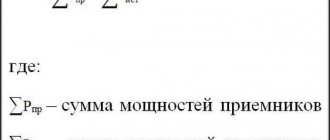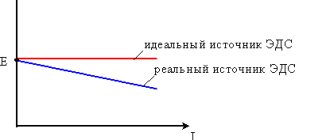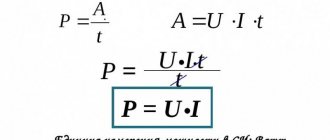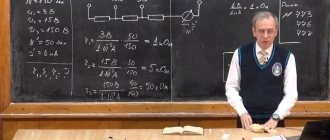Most household appliances connected to the network are characterized by such a parameter as the electrical power of the device. From a physical point of view, power is a quantitative expression of the work done. Therefore, to evaluate the effectiveness of a device, you need to know the load it will create in the circuit. Next, we will look at the features of the concept itself and how to find the current power, having various characteristics of the device itself and the electrical network.
The concept of electrical power and methods for calculating it
From an electrical engineering point of view, it is a quantitative expression of the interaction of energy with conductor material and elements during the flow of current in an electrical circuit. Due to the presence of electrical resistance in all parts involved in conducting electric current, the directional movement of charged particles encounters an obstacle along the way. This causes the collision of charge carriers, electrical energy transforms into other forms and is released in the form of radiation, heat or mechanical energy into the surrounding space. The conversion of one type to another is the power consumption of the device or section of the electrical circuit.
Depending on the parameters of the current and voltage source, power also has distinctive characteristics. In electrical engineering it is denoted by S, P and Q, the unit of measurement according to the international SI system is watts. Power can be calculated through various parameters of instruments and electrical appliances. Let's look at each of them in more detail.
Through voltage and current
The most relevant way to calculate power in DC circuits is to use current and applied voltage data. To do this you need to use the calculation formula: P = U*I
Where:
- P – active power;
- U – voltage applied to a section of the circuit;
- I is the strength of the current flowing through the corresponding section.
This option is only suitable for active loads, where direct current does not provide interaction with the reactive component of the circuit. To find power you need to multiply current and voltage. Both quantities must be in the same units of measurement - Volts and Amperes, then the result will also be in Watts. You can use other methods kV, kA, mV, mA, μV, μA, etc., but the power parameter will proportionally change its decimal value.
Through tension and resistance
For most electrical devices, such a parameter is known as internal resistance, which is taken as a constant for the entire period of their operation. Since domestic or industrial units are connected to a source with a known voltage rating, determining the power is quite simple. The active power is found from the previous relationship and Ohm's law for a section of the circuit, according to which the current in the section is directly proportional to the magnitude of the applied voltage and has inverse proportionality to the resistance:
I = U/R
If the expression for calculating the current load is substituted into the previous formula, you will get the following expression for determining the power:
P = U*(U/R)=U2/R
Where,
- P – load value;
- U – applied potential difference;
- R – load resistance.
Through current and resistance
There is a situation when the potential difference applied to an electrical device is unknown or requires labor-intensive calculations, which is not always convenient. This issue is especially relevant if several devices are connected in series and you do not know how the consumed electricity is distributed between them. The definition approach here is no different from the previous method; it is based on the basic statement that the electrical load is calculated as P = U×I , with the difference that we do not know the voltage.
Therefore, we will also derive it from Ohm’s law, according to which we know that the voltage drop on any section of a line or electrical installation is directly proportional to the current flowing through this section and the resistance of the circuit section:
U=I*R
after substituting the expression into the power formula, we get:
P = (I*R)*I =I2*R
As you can see, the power will be equal to the square of the current multiplied by the resistance.
Apparent power in AC circuit
AC networks are fundamentally different from direct current in that changes in electrical quantities lead to the appearance of not only an active, but also a reactive component. As a result, the total power will also consist of active and reactive energy:
Where,
- S – total power
- P – active component – occurs when electric current interacts with active resistance;
- Q – reactive component – occurs when electric current interacts with reactance.
Also, the components are calculated through trigonometric functions, like this:
P = U*I*cosφ
Q = U*I*sinφ
which is actively used in the calculation of electrical machines.
Rice. 1. Power triangle
Determination of power by current consumption
How to determine the power consumption of a mobile device if its maximum power is not indicated on it? To do this, you need to know the voltage and current. The voltage of all electrical networks in the CIS is standard and is 220 V. However, chargers use a voltage of only 5 V.
The current consumed may vary. For mobile phones or tablets, 1 A chargers are usually used, and for electronic vapor generators (vape mods) - 2 A. It is known that it takes an average of 4 hours to fully charge a device. Thus, the mobile phone consumes:
5 × 1 × 4 = 20 Wh,
and an electronic steam generator:
5 × 2 × 4 = 40 Wh
Consequently, we additionally spend about 1 kW/h per month to charge mobile devices.
Our program uses a similar calculation algorithm to determine energy costs. In this article, we calculated energy consumption manually. The calculator calculates everything automatically. You only need to indicate the operating time per day/week/month and the power of the selected electrical appliances. After this, indicate the cost of one kWh in your region and click the “Calculate” button. The program will display a table of electricity consumption and its cost per day/week/month/year.
You can also calculate the cost of electricity based on the amount of energy you already know. To do this, select the “Consumption” option in the calculator menu and indicate energy consumption in kWh for 1 year. For example, if you have printouts from your electricity supplier for your consumption during the previous year, you can use this value to run our calculator.
Example of calculating total power for an electric motor
Of particular interest is the load connected to a three-phase network, since the electrical quantities flowing in it directly depend on the rated load of each phase. But to make the example clearer, we will not consider how to find the power of an asymmetrical device, since this is a rather complex task, but we will give an example of calculating a three-phase motor.
The peculiarity of the power supply of both asynchronous and synchronous electric machines is that both phase and linear voltage can be supplied to the windings. This or that option, as a rule, is determined by the method of connecting the electric motor windings. Then the power will be calculated using the formula:
S = 3*Uф*Iф
In the case of performing calculations with linear voltage, to find the power, the formula will take the form:
Active and reactive power will be calculated by analogy with alternating current networks, as discussed earlier.
Now let's look at the calculations using the example of a specific asynchronous electric machine. It should be noted that the official performance indicated in the passport data of the electric motor is the useful power that the engine can produce when making shaft revolutions. However, useful is fundamentally different from total, which can be calculated using power factor.
Rice. 2. Motor nameplate
As you can see, for calculations from the nameplate we will take the following information about the electric motor:
- useful performance – 3 kW, and translated into a measurement system – 3000 W;
- efficiency factor is 80%, and in recalculation for calculations we will use the indicator 0.8;
- trigonometric function of the ratio of active and reactive components – 0.74%;
- the voltage when connecting the windings in a triangle will be 220 V;
- current strength with the same connection method is 13.3 A.
With this list of characteristics, you can use several ways:
S = 1.732*220*13.3 = 5067 W
To find the desired value, we first determine the active component:
P = Puseful / efficiency = 3000/0.8 = 3750 W
Further, complete by the method of dividing the active by the coefficient cos φ:
S = P/cos φ = 3750/0.74 = 5067 W
As you can see, in both the first and second cases the desired value turned out to be the same value.
Single-phase and three-phase current
A single-phase network can be compared to a country road - it does not allow you to get more power. A three-phase network can be compared to a motorway - it is usually found in industrial buildings to power high-power equipment
Pole-mounted single-phase transformer designed to supply electrical power to single-family homes (Canada)
The term "phase" refers to the distribution of electrical energy. For people far from physics, single-phase and three-phase networks can be compared with the illustrations above. A single-phase network is like a country road, its power capabilities are low and it is used mainly in residential buildings and apartments. Single-phase network is simple and economical. However, a single-phase network cannot be used to power efficient three-phase electric motors. On the other hand, a three-phase network is like a highway, it allows the use of powerful loads and is usually used in industrial buildings and much less often in individual residential buildings and apartments. All large energy consumers such as water heaters, large electric motors and air conditioning systems are usually connected to a three-phase network.
A single-phase network uses two or three wires. There is always one phase wire and one wire called the neutral or neutral wire. Current flows between these two wires. If a single-phase network contains a ground wire, then a three-wire network is used. A single-phase network is good where typical loads are purely active consumers, such as traditional incandescent lamps and electric heaters. A single-phase system is not suitable for powering powerful electric motors.
Pole-mounted group of three transformers providing three-phase power to a small industrial installation
A three-phase network uses three wires, called phases or simply phases. Sinusoidal currents flow through these wires with a phase shift relative to each other by 120°. A three-phase system may have three or four wires. If there is a fourth wire, then a three-phase network can be used to supply single-phase power (three lines), for example, to individual residential buildings. In this case, approximately the same power is supplied from each phase to the load (house). The neutral wire often has a smaller cross-section because the phase currents cancel each other out and very little current usually flows through the neutral wire. The three-phase system ensures a constant transfer of power to the load, allowing higher loads to be connected.
Examples of problems
For example, let's consider calculations on sections of an electrical circuit with serial and parallel connections of elements. The first option provides for a situation where all parts are connected one after another from one pole of the power source to the other.
Rice. 3. Sequential calculation circuit
As you can see in the figure, as a source we use a battery with a nominal voltage of 9 V and three resistors of 10, 20 and 30 Ohms, respectively. Since the rated current is not known to us, we will make the calculation using voltage and resistance:
P = U2/R = 81 / (10+20+30) = 1.35 W
For a parallel connection diagram, let's take as an example a section of a circuit with two resistors and one current source:
Rice. 4. Parallel connection diagram
As you can see, for the convenience of calculations, we need to bring the resistors connected in parallel to an equivalent circuit, which will result in:
Rtot = (R1*R2) / (R1+R2) = (10*15) / (10+15) = 6 Ohm
Then we can find out the required load rating through the value of current and resistance:
P = I2*R = 25*6 = 150 W
Definition
Power is a scalar quantity. In general, it is equal to the ratio of work performed to time:
P=dA/dt
In simple words, this value determines how quickly work is completed. It can be designated not only by the letter P, but also by W or N, and is measured in Watts or kilowatts, which are abbreviated as W and kW, respectively.
Electrical power is equal to the product of current and voltage or:
P=UI
How does this relate to work? U is the ratio of work to transfer a unit charge, and I determines how much charge passed through the wire per unit time. As a result of the transformations, a formula was obtained with which you can find the power, knowing the current strength and voltage.
Formulas for DC circuit calculations
The easiest way to calculate the power is for a DC circuit. If there is current and voltage, then you just need to perform the calculation using the formula given above:
P=UI
But it is not always possible to find power by current and voltage. If you don't know them, you can determine P by knowing the resistance and voltage:
P=U2/R
You can also perform the calculation knowing the current and resistance:
P=I2*R
The last two formulas are convenient for calculating the power of a section of a circuit if you know the R of the element I or U that falls on it.











